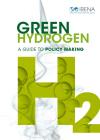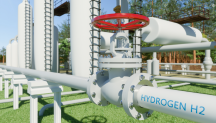

-
-
IRENA (2020), Green Hydrogen: A guide to policy making, International Renewable Energy Agency, Abu Dhabi
Copied
/-/media/Files/IRENA/Agency/Publication/2020/Nov/IRENA_Green_hydrogen_policy_2020.pdf?rev=c0cf115d8c724e4381343cc93e03e9e0
Copied
Green hydrogen: A guide to policy making
Newsletter
Hydrogen produced with renewable energy sources – or “green” hydrogen – has emerged as a key element to achieve net-zero emissions from heavy industry and transport. Along with net-zero commitments by growing numbers of governments, green hydrogen has started gaining momentum based on low-cost renewable electricity, ongoing technological improvements and the benefits of greater power-system flexibility.
The report is also available in Chinese (中文)
Hydrogen-based fuels previously attracted interest mainly as an alternative to shore up oil supply. However, green hydrogen, as opposed to the “grey” (fossil-based) or “blue” (hybrid) varieties, also help to boost renewables in the energy mix and decarbonise energy-intensive industries.
This report from the International Renewable Energy Agency (IRENA) outlines the main barriers that inhibiting green hydrogen uptake and the policies needed to address these. It also offers insights on how to kickstart the green hydrogen sector as a key enabler of the energy transition at the national or regional level.
See also a compilation of two IRENA reports on hydrogen: Making the Breakthrough: Green hydrogen policies and technology costs
Key pillars of green hydrogen policy making include:
- National hydrogen strategy. Each country needs to define its level of ambition for hydrogen, outline the amount of support required, and provide a reference on hydrogen development for private investment and finance.
- Setting policy priorities. Green hydrogen can support a wide range of end-uses. Policy makers should identify and focus on applications that provide the highest value.
- Guarantees of origin. Carbon emissions should be reflected over the whole lifecycle of hydrogen. Origin schemes need to include clear labels for hydrogen and hydrogen products to increase consumer awareness and facilitate claims of incentives.
- Governance system and enabling policies. As green hydrogen becomes mainstream, policies should cover its integration into the broader energy system. Civil society and industry must be involved to maximise the benefits.
This is the first guide in a series of reports designed to explore policies to support green hydrogen. The second one, published in May 2021, Green hydrogen supply: A guide to policy making, explored the challenges for green hydrogen production and the third one, published in March 2022, Green hydrogen for industry: A guide to policy making, highlighted the range of policy options available in the industrial sector.




